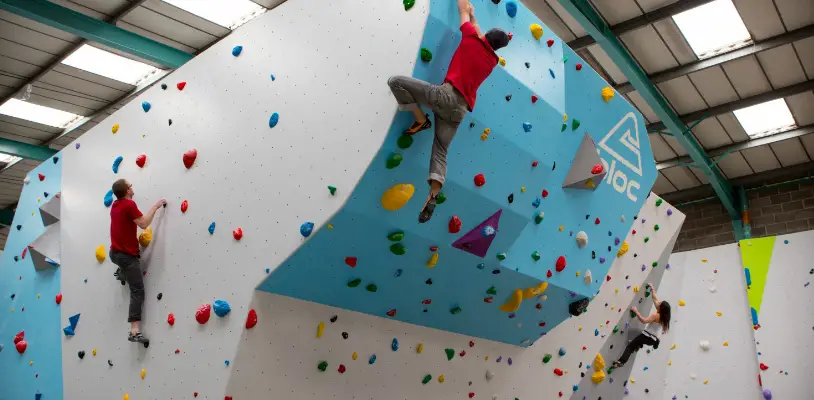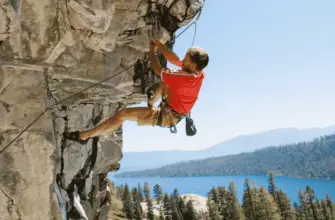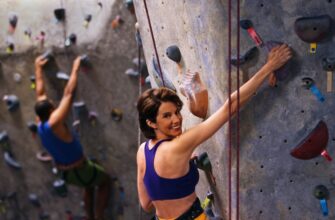If you’re interested in getting started in bouldering and already bought climbing shoes, but still have a few questions about this activity, then this article is definitely for you! Do you want to know bouldering wall height? Typically, looking up at a climbing wall (even if it’s a home climbing wall or a gym wall), you will tell “too high” for sure, especially if you’re afraid of heights. But you probably want to know bouldering wall height.

- What is a Climbing Wall?
- Bouldering wall height for different types of climbing walls
- Bouldering walls
- Rope walls
- Lead climbing walls
- Overhanging walls
- Types of climbing
- What are the minimum and maximum heights for wall climbing?
- What is the difference between the walls beside the height?
- What are the restrictions?
- FAQ
- How tall is a indoor bouldering wall?
- How tall are bouldering walls in meters?
- How tall does a climbing wall need to be?
- Results
What is a Climbing Wall?
A climbing wall is a specially designed wall for rock climbing, which is often built to stimulate rocky surfaces. This is a man-made wall with grips for arms and legs, designed for indoor and sometimes outdoor climbing.

Some climbing walls are wooden, some are made of thick multilayer boards, and some are made of aluminum and steel. There are usually always places on the climbing walls for attaching ropes (safety ropes).
They can be used for various exercises, including, obviously, bouldering. All climbing walls are made exclusively to imitate real stone. The climbing walls can be made from a variety of materials.
Many walls have wooden bases with synthetic plaster supports screwed to them, and many are made of fiberglass, concrete-like material, or metal. The material of the wall will determine its strength. For example, bouldering or top rope climbing walls does not have to be strong.
The lead climb walls must be strong enough to withstand the force of falling lead. The bolts in this wall must be well secured and placed on very secure surfaces. It is worth noting that the construction of the lead climbing wall is more expensive, and the lead climbing walls themselves take up a lot of space, but at the same time, they are very reliable.
For an indoor climbing gym, you can use a plaster base to create holds and a wooden board or house wall to secure them. Supports can also be made from a turf wall for a more natural look. Walls can be made from any material! However, the most common materials are gypsum and wood.
Climbing walls are built so that climbers can always continue their training under adverse hiking conditions. In recent years, indoor climbing has become very popular.
Indoor climbing has greatly popularized the art of rock climbing. Many people have taken up this sport not only for bouldering itself but also to meet new people and communicate. It’s a wonderful team-building activity. Its main goal is to reach the top or end point of the route without falling.
Rock climbing was included for the first time in the Tokyo 2021 Olympic Games. Amazingly, there are members of this sport who have never had outdoor climbing experience. There are specialized sports centers for bouldering. Doing this sport gives unforgettable emotions: adrenaline, fear, a unique atmosphere, lots of communication, and a pleasant pastime.
Bouldering wall height for different types of climbing walls
Bouldering walls
Bouldering walls are often at least 10 feet in height. It allows you to build a route and make several movements to reach the top of the wall. It is worth noting that short boulder walls have many routes that cross the wall and more routes that involve a sit-down start. Sitting starts to allow for interesting routes and the use of every foot of space on a shorter boulder wall.

Indoor bouldering walls are on average 15 feet high and 98 feet wide. This allows you to use 10 routes at the same time. The minimum width of each route is 10 feet. The wall eaves have different profiles, with an average angle of 30°, a minimum of 5°, and a maximum of 60°.
Rope walls
There are higher climbing walls that are designed exclusively for rope climbing, not lead climbing. Such walls reach a height of at least 20 feet. Top rope walls are available from 40 feet for increased maneuverability when climbing.

Lead climbing walls
Such lead climbing walls tend to be at least 25 feet or 40 feet. This is done to provide enough space and they are generally dangerous for the untrained climber. The lead climbing walls should provide plenty of room for maneuvering and routes, as well as safety in case of a possible fall.

On average, a good lead climbing wall is about 49 feet high. The minimum height is 43 feet and the maximum height is 59 feet. This allows you to use 4 routes at the same time. One route is at least 10 feet wide.
Overhang averages 30 feet, with 23 feet being the minimum and 36 feet being the maximum. Profiles with an average slope of about 30°. For them, the minimum value you will see is 10° and the maximum is 60°. North or northeast is usually the orientation, and coverage is at least 3 feet of climbing walls.
The horizontal spacing between anchors must be less than 3 feet to allow the routes of the climbing wall to be curved. The angles between two panels should never exceed 120°.
Overhanging walls
Overhanging walls, whether the ledge is on a lead climbing wall or a bouldering wall, many gyms have ledges installed in places where they are physically constrained by the building or space. The overhang climbing is extremely difficult and interesting because you are climbing up and out.

Types of climbing
Now that we have explored the different types of climbing walls, let’s explore the types of climbing in more detail.
Bouldering. The most common type of climbing that does not require a rope and can be done without assistance on shorter walls. It involves climbing without the use of ropes.

Highballing is similar to bouldering, except that it is extremely dangerous due to the increased maximum height that can reach 40 feet without a rope. Highballing is practiced on a rock.

Lead climbing is a style where one climber has to be the leader and the other climbers follow him. The lead climber wears a harness attached to a climbing rope which is in turn to the climbers below.

Free solo is the most dangerous type of climbing. This is bouldering climbing, in which you need to climb to a climbing wall with a height of more than 40 feet.

Climbing has several different names, but they all have one thing in common – it is a type of group fitness hike with the safe passage of physically difficult routes.
What are the minimum and maximum heights for wall climbing?
The minimum height of a climbing wall depends on what will be happening on that climbing wall. As we have already found out, the height of a wall for bouldering will be very different from the height of a lead climbing.
If you’re going to an indoor climbing wall, the climbing area, for example with rope, will be 40 to 60 feet, with an average height of 50 feet. All this is done to create as many varied and interesting climbing routes as possible.

It’s also worth noting that climbing walls are also available outdoors and can be up to 100 feet high! They can be attached to any building and be multi-stage. That is, the route can reach 250 feet!
Width is also an important factor. Adequate space must be provided for the various routes, and thus the walls are usually at least 20 feet wide, but can also be hundreds of feet wide if space permits.
What is the difference between the walls beside the height?
Very important to characterize a good climbing wall is insurance. When climbing the top rope, a top harness must be attached to the harness. When you do bouldering climbs you are not tied down with harnesses or ropes as the height is not that great and the mats underneath cushion any falls.
In bouldering, there is always only one way down – to fall. The very fall is softened by the softness of the floor. At the same time, when climbing a rope, belay is very important.

The thickness of the climbing walls is usually one inch for every foot. So that a 13-foot climbing wall will have a 13-inch floor to protect against falls. Thick and soft bouldering floor padding is counterproductive for a top rope wall.
Also, in addition to safety standards, another factor is the reduction of liability in case of injury on the climbing wall. Climbing is a dangerous activity. Therefore, gyms are trying to find a balance between building interesting routes and the possibility of injury. This is an important factor that mediates the height of interior bouldering walls.
Thus, it is not always possible to draw the dependence of the quality of the wall on its height. Yes, there are more features, but also more security and hardware requirements. Tall walls give a sense of adventure and adrenaline.
Therefore, it usually depends on the climber himself whether he wants to climb high or not. It is worth remembering that the higher the climbing walls, the better you need to design the route.
What are the restrictions?
An important limitation of climbing walls is the price of available materials. Most climbing walls use colored plastic holds to create routes. This option is economical, allows a large number of route options and objects, and can be used to create a specific route. The design and appearance of a climbing wall play a huge role in many decisions and requires more space.
Limiting the number of colored plastic holds creates cracks in the climbing walls. This allows the wall to look more natural but reduces the possibility of changing the routes on the climbing walls.
It is worth pointing out that standard sports floors are not suitable for rock climbing and great care must be taken when laying floors under the upper climbing walls and climbing areas.
There is no standard for fall absorption, so it is recommended that you use what is most effective in preventing tragedy. However, there is no recommended material for fall absorption. It is important first of all to ensure the safety of people, so almost any effective softening materials are used.

For example, rubber balls, tiles and soft surfaces of playgrounds, and mats used for wrestling. The more popular rock climbing, the more options.
Rope climbing walls allow for cheap flooring. Each square foot of space costs approximately $10 to $16. Bouldering floors can cost more. For example, a minimum of $35 per square foot. However, the most costly can be fines for those who are injured due to a lack of proper safe coverage.
Some climbing gyms may also invest in pourable rubber flooring, which is quite an expensive material.
It can be added that who exactly uses the climbing wall also plays an important role here. Gyms targeting a younger and non-professional audience are interested in thicker and softer padding.
That is, when a larger person falls off a wall, they have more surface area to evenly distribute that weight on the landing surface. At the same time, when a child lands on an adult bouldering floor, it will be too hard for him to fall.
Thus, the correct floor covering is a decisive factor in the safety of the climber and climbing walls. High walls don’t pose as much of a hazard if fall zone coverage is done properly. Soft flooring is always the best option for bouldering. When looking for climbing gyms, you should look down as well as up to cushion your fall.
FAQ
How tall is a indoor bouldering wall?
On average, bouldering walls are at least two feet high, as this allows you to move a bit before you reach the top of the wall.
Top rope walls are usually at least 30 or 40 high.
The shortest lead wall is at least 25 feet. These walls are very high, due to the very type of activity and the need to climb up in a group. Thus, a lead climbing wall should be about 40 feet higher than a standard bouldering wall to ensure free movement and safety for the group.
Thus, on average, the height of a climbing wall can vary from 10 to 40 feet. It all depends on the type of climbing.
How tall are bouldering walls in meters?
On average, climbing walls are between 4.5 – 15 meters high.
How tall does a climbing wall need to be?
Depends on the type of climbing. The more difficult your type of climbing is, the more altitude you need. All this is necessary to maintain the variability of the laid routes and more reliable safety for the climber.
Results
It can be concluded that there are only average values for different types of climbing and different height ranges depending on the specific gym. It is important to remember that it is not only the height of the wall that matters.
The climbing walls can be short if the routes themselves are well-built and interesting, and the wall itself and the surface below are reliable.
However, it is worth noting that the climbing walls should not be too high either, because this makes it difficult to ensure the safety of climbers. Every climber should remember that what matters most is how you feel when you practice on specific climbing walls. The higher climbing wall is not always better! Read about the best ways of climbing warm-up











